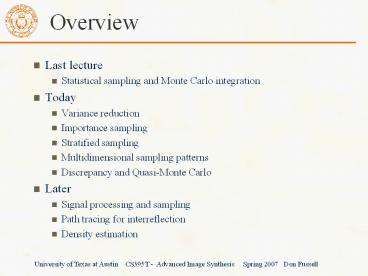Overview - PowerPoint PPT Presentation
Title:
Overview
Description:
Last lecture Statistical sampling and Monte Carlo integration Today Variance reduction Importance sampling Stratified sampling Multidimensional sampling patterns – PowerPoint PPT presentation
Number of Views:88
Avg rating:3.0/5.0
Title: Overview
1
Overview
- Last lecture
- Statistical sampling and Monte Carlo integration
- Today
- Variance reduction
- Importance sampling
- Stratified sampling
- Multidimensional sampling patterns
- Discrepancy and Quasi-Monte Carlo
- Later
- Signal processing and sampling
- Path tracing for interreflection
- Density estimation
2
Cameras
Depth of Field
Motion Blur
Source Cook, Porter, Carpenter, 1984
Source Mitchell, 1991
3
Variance
1 shadow ray per eye ray
16 shadow rays per eye ray
4
Variance
- Definition
- Properties
- Variance decreases with sample size
5
Variance Reduction
- Efficiency measure
- If one technique has twice the variance of
another technique, then it takes twice as many
samples to achieve the same variance - If one technique has twice the cost of another
technique with the same variance, then it takes
twice as much time to achieve the same variance - Techniques to increase efficiency
- Importance sampling
- Stratified sampling
6
Biasing
- Previously used a uniform probability
distribution - Can use another probability distribution
- But must change the estimator
7
Unbiased Estimate
- Probability
- Estimator
8
Importance Sampling
Sample according to f
9
Importance Sampling
- Variance
10
Example
method Sampling function variance Samples needed for standard error of 0.008
importance (6-x)/16 56.8N-1 887,500
importance 1/4 21.3N-1 332,812
importance (x2)/16 6.4N-1 98,432
importance x/8 0 1
stratified 1/4 21.3N-3 70
Peter Shirley Realistic Ray Tracing
11
Examples
Projected solid angle 4 eye rays per pixel 100
shadow rays
Area 4 eye rays per pixel 100 shadow rays
12
Irradiance
- Generate cosine weighted distribution
13
Cosine Weighted Distribution
14
Sampling a Circle
Equi-Areal
15
Shirleys Mapping
16
Stratified Sampling
- Stratified sampling is like jittered sampling
- Allocate samples per region
- New variance
- Thus, if the variance in regions is less than the
overall variance, there will be a reduction in
resulting variance - For example An edge through a pixel
17
Mitchell 91
Uniform random
Spectrally optimized
18
Discrepancy
19
Theorem on Total Variation
- Theorem
- Proof Integrate by parts
20
Quasi-Monte Carlo Patterns
- Radical inverse (digit reverse) of integer i in
integer base b - Hammersley points
- Halton points (sequential)
1 1 .1 1/2
2 10 .01 1/4
3 11 .11 3/4
4 100 .001 3/8
5 101 .101 5/8
21
Hammersley Points
22
Edge Discrepancy
Note SGI IR Multisampling extension 8x8
subpixel grid 1,2,4,8 samples
23
Low-Discrepancy Patterns
Process 16 points 256 points 1600 points
Zaremba 0.0504 0.00478 0.00111
Jittered 0.0538 0.00595 0.00146
Poisson-Disk 0.0613 0.00767 0.00241
N-Rooks 0.0637 0.0123 0.00488
Random 0.0924 0.0224 0.00866
Discrepancy of random edges, From Mitchell
(1992) Random sampling converges as
N-1/2 Zaremba converges faster and has lower
discrepancy Zaremba has a relatively poor blue
noise spectra Jittered and Poisson-Disk
recommended
24
High-dimensional Sampling
- Numerical quadrature
- For a given error
- Random sampling
- For a given variance
Monte Carlo requires fewer samples for the same
error in high dimensional spaces
25
Block Design
Latin Square
26
Block Design
N-Rook Pattern
Incomplete block design Replaced n2 samples with
n samples Permutations Generalizations
N-queens, 2D projection
27
Space-time Patterns
- Distribute samples in time
- Complete in space
- Samples in space should have blue-noise spectrum
- Incomplete in time
- Decorrelate space and time
- Nearby samples in space should differ greatly in
time
Cook Pattern
Pan-diagonal Magic Square
28
Path Tracing
4 eye rays per pixel 16 shadow rays per eye ray
64 eye rays per pixel 1 shadow ray per eye ray
Complete
Incomplete
29
Views of Integration
- 1. Signal processing
- Sampling and reconstruction, aliasing and
antialiasing - Blue noise good
- 2. Statistical sampling (Monte Carlo)
- Sampling like polling
- Variance
- High dimensional sampling 1/N1/2
- 3. Quasi Monte Carlo
- Discrepancy
- Asymptotic efficiency in high dimensions
- 4. Numerical
- Quadrature/Integration rules
- Smooth functions































